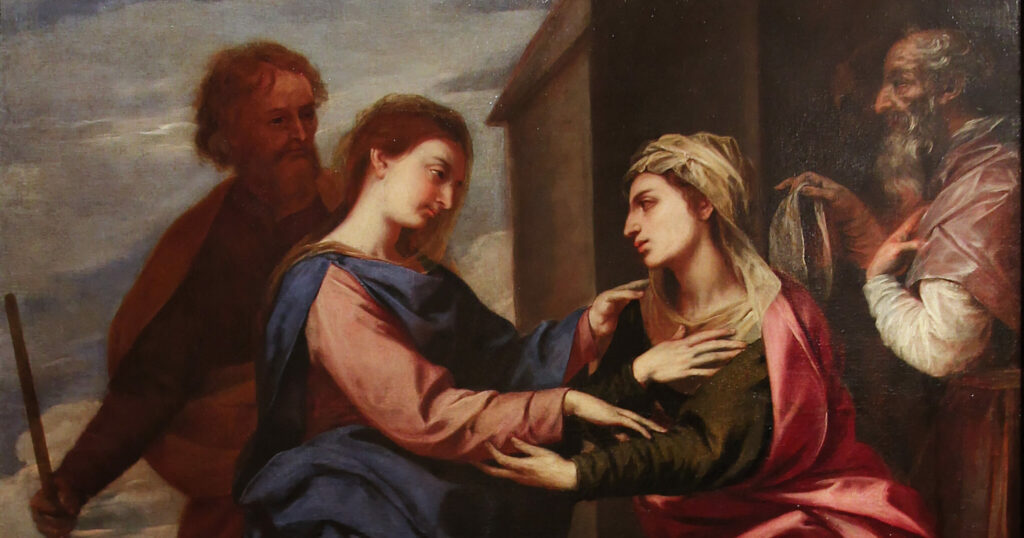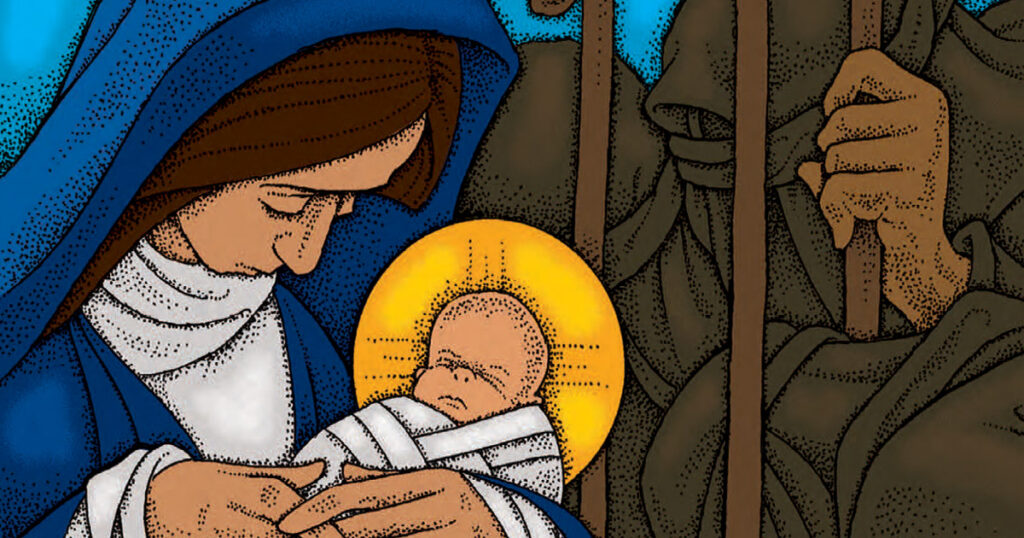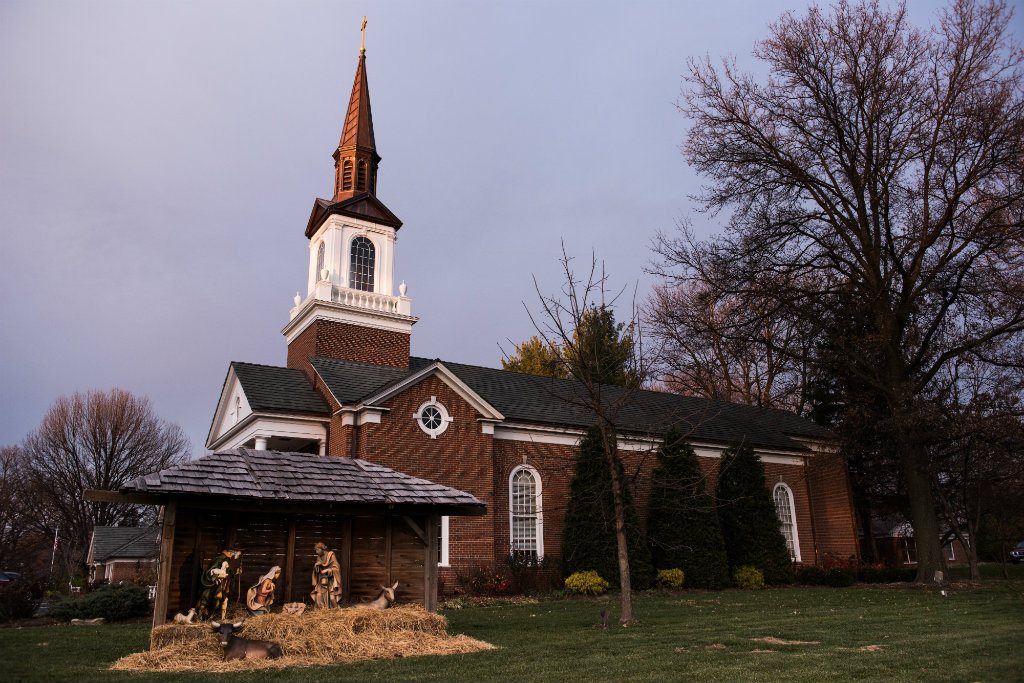How Christ’s birth hallows all births and all of bodily life
By Josh Pauling
The Bible is an earthy, fleshy book. God forms Adam from dirt. He fashions Eve from Adam’s rib. They eat forbidden fruit and use animal skin for covering. There are pillars of smoke and fire, roasted lambs and bitter herbs, bloody sacrifices and clouds of temple incense. And not only in the Old Testament — the New Testament continues with such physicality. Jesus heals with spit and dirt, fingers in ears, and caskets touched. A bloody cross culminates in bodily resurrection. Finally, He promises the resurrection of our bodies and a renewed physical earth.
Biblical salvation is not an offer to escape the body into some disembodied realm, whether platonic, gnostic, Eastern, transhumanist or anything else. Rather, the Bible deeply anchors redemption itself to the body. God carries out His redemptive deliverance through intense bodily realities from creation to consummation.
The Christmas story is also grounded in physicality: a pregnancy. There is not much that is more utterly human than giving birth and being born. This fact — that God has taken on flesh in the virgin’s womb — is like a diamond held up to the light. The more you behold its mysteries, the more facets of beauty and wonder you perceive, and the more implications for life emerge in the blessings of birth and embodiment. The Christmas story reflects the subversive and compelling role for the church and the family in a society that has forgotten what it means to be human.
The Visitation: The Wombs of Elizabeth and Mary
The meeting of Mary and Elizabeth overflows with the physicality and joyful anticipation of birth. Echoing an Old Testament theme with women like Sarah, aging Elizabeth — who is beyond childbearing age — nevertheless bears John, the man who would plunge Christ into the waters of the Jordan. Then there is young Mary, the virgin, who bears Jesus, the God-man who came to plunge people into His life-giving kingdom waters. These bookends of maternity — the elderly mother of the greatest born of women under the old covenant, and the virgin mother of the incarnate mystery of the ages — embed the great acts of redemption in the family, much like God’s promise to Abraham that through his offspring “shall all the nations of the earth be blessed” (Gen. 22:18).
The bodily realities of birth are central to the redemptive work of God in Christ. The forerunner and the King both await their destinies as helpless babes in the watery wombs of their mothers. The greatest of the old age and the Ancient of Days meet from inside the bodies of another in a mystery that is visceral and real, enchanting and wonderful. No wonder John leapt for joy. No wonder Elizabeth exclaimed, “Blessed is the fruit of your womb!” (Luke 1:42). And no wonder Mary magnified the Lord (Luke 1:46–56).
John and Jesus are not isolated bodies, but bodies in relation to other bodies — bodies situated in family structures. Elizabeth and Zechariah and Mary and Joseph nurture and raise John and Jesus, as we see the complementarity of men and women in the blessed Trinity’s work of redemption. Christ’s coming in this specific way — birthed through the waters of Mary, nursed at her breast, raised in a family, trained as a craftsman by Joseph — elevates and sanctifies all births and all aspects of life.
The Purification: Firstborn of Mary, Firstborn of All Creation
The purification of Mary also deserves our contemplation. Luke recounts that “when the time came for their purification according to the Law of Moses, they brought him up to Jerusalem to present him to the Lord” (Luke 2:22). Then Luke hearkens back to the Exodus command that “every male who first opens the womb shall be called holy to the Lord” (Luke 2:23). “Whatever is the first to open the womb,” Yahweh said to Moses, “is mine” (Ex. 13:2). This sanctifying of the firstborn served as both a firstfruits offering and a re-participation in God’s deliverance from Egypt in the final plague of the firstborn, from which the Israelites were protected through the blood of a sacrificial lamb. Jesus, as the first to open Mary’s virgin womb, is the reality to which the firstfruits offering to the Lord pointed and the true sacrificial lamb portrayed in type and shadow in the Exodus Passover.
The firstborn of Mary is the firstborn of all creation, who ushers in a new creation. The language of Christ as firstborn and firstfruits permeates the New Testament. In His birth not only is Christ set apart as Mary’s firstborn, He, as the firstborn of all creation, brings others in His train. The firstborn of all creation is the “firstborn from the dead” who will “reconcile to himself all things” (Col. 1:18, 20; see also vv. 15–19). Christ, the incarnate and now resurrected one, is “the firstfruits of those who have fallen asleep” (1 Cor. 15:20). Christ is “the firstborn among many brothers” (Rom. 8:29) who gives us “the firstfruits of the Spirit” (Rom. 8:23) as we and all creation wait “with eager longing for the revealing of the sons of God” (Rom. 8:19; see also vv. 18–30). All of human life is folded into His life and remade in Him. This is a hallowing act — a hallowing of birth, of life, of children. A new creation story has begun. The firstborn of all creation — the One who is begotten, not made — is somehow born, lives, dies, rises and now brings us with Him into His divine life.
What This All Means: How the Nativity Subverts the Spirit of the Age
The wonder of the Incarnation never runs dry. It is indeed the mystery “hidden for ages and generations but now revealed to his saints” (Col. 1:26). These are the “things into which angels long to look” (1 Peter 1:12). But the nativity narrative does more than announce the Messiah’s arrival or reveal the mystery of the ages. It inaugurates a new way of being that subverts the powers that be; it upends cultural narratives and turns conventional life scripts on their heads — then and now. I offer here a few of the ways that Christ’s birth provides a beautiful archetype of life in our culture of death.
1. Christ’s birth subverts the autonomous individualism of our age.
We live in a society driven by the drumbeat of self-creation and expressive individualism that echoes in our ears nonstop: “Be yourself. Express yourself. Live your truth.” The nativity stops the music. God’s descent to us in the form of a dependent little baby sets a completely different tune that marches to a different drummer.
The nativity’s subversive drumbeat tells us, “We are not our own. We cannot save ourselves. We are dependent on another.” This is good news. Self-creation is exhausting and ultimately impossible. For anyone who takes life the least bit seriously, self-creation easily morphs into an anxiety-inducing burden bigger than our shoulders are designed to bear. Christ’s birth into real history tells us that we must be re-created and remade in Christ, who stakes a claim on us and reorients our identity around the patterns and rhythms of His body, His life, His work. We are given the ultimate identity-makers of Word and Sacrament, which unite us to Him and His perfect life, death and resurrection, and plant us deep in His Body, the church, with many members with different gifts.
2. Christ’s birth subverts the power dynamics of our age.
The world is consumed with power. Political parties seek power over principle. Institutions leverage power to cover up scandal. Churches and ministry leaders are also not immune to misuses of power. But it also hits much closer to home when we are honest with our own twisted hearts. We, too, misuse power in our personal lives, in our homes and in the workplace when we exercise even the small bits of authority we have for our own self-interest and personal gain. With such perennial temptations to misuse authority it is easy to view everything through the lens of power dynamics. Race relations, gender roles, economic disparities, religion itself — all are mere power plays. Every relationship is one of victim and victimizer, oppressed and oppressor. While this may be a tidy way to view the world, it is not God’s way.
As an alternative to today’s irredeemable power dynamics, there is an astonishing paradigm God orchestrates throughout the Scriptures — a real, historical story that is about not the accumulation of power but the willing relinquishment of it. Even God Himself takes “the form of a servant, being born in the likeness of men” (Phil. 2:7). The flow of redemptive history from Genesis to Revelation consistently upends our expectations of power and privilege revealing how “the foolishness of God is wiser than men, and the weakness of God is stronger than men” (1 Cor. 1:25). Even in this jaded age there remains a jolt of hope, a flash of something unexpected, unlikely and shockingly wonderful: the powerless babe in a manger, the stripped Christ on a cross, the victorious yet slaughtered Lamb — the God who wins by losing. These are God’s power dynamics — the upside-down and paradoxical kingdom of Christ the Crucified, where weak things shame the strong, where least becomes greatest, where Word becomes flesh. The Messiah rules and reigns not from a glorious throne of political pomp and military circumstance, but as He overturns and inverts the spirit of the age with the powerlessness of His manger; the foolishness of His cross; and His mundane means of Baptism, Word and Supper.
3. Christ’s birth hallows the family estate.
According to a 2023 Pew Research parenting study, nearly 90% of parents surveyed found it extremely important that their children be financially independent and have careers they enjoy, while only 20% said it was important that their children marry and have children. Furthermore, just 35% of parents found it very important that their children have similar religious beliefs to their own.[1] Declining birth and marriage rates and high de-churching rates are further evidence that we have been catechized all too well into the American creed of careerism, consumerism, personal fulfillment and the pursuit of happiness.
The nativity breaks through with a claim that is countercultural to its core — that God became man within a family. Though born of a virgin, Jesus was not an isolated individual on a journey of self-fulfillment. As part of a family, He grew “in wisdom and in stature and in favor with God and man” (Luke 2:52). The family is one of God’s primary frameworks for human flourishing. In the family God grants us the privilege to witness His miraculous workings of creation and redemption through natural birth and spiritual rebirth. The creational order of family is not only upheld and honored in the nativity but is elevated in Christ, who unites around Himself the eschatological family, where we are made children of God. We are birthed through the waters of our mother, the church, into new life in Christ, our elder brother, who shares with us His communion with the Father through the Spirit.
4. Christ’s birth hallows embodiment.
Contemporary culture is not quite sure what to do with the body. For some, it is a shell to be discarded (i.e., refusing the honor of burial, human composting). For others, it is something to be molded and modified in accord with the internal self and personal will (i.e., transhumanism, transgenderism) or sexualized and objectified (i.e., pornography, fitness obsession). Then there are those for whom the body is solely biological matter whose value is determined by ability or status (i.e., abortion, euthanasia). Since its earliest days, the church has faced similar challenges to the centrality of embodiment, whether from docetists claiming Christ only seemed to have a body or from gnostics seeking liberation from the body. The church has always grounded its responses in the Incarnation.
God in the feeding trough is a breathtaking confession of the goodness of the body. Embodiment is a gift and is central to how God reveals Himself to us and how we reflect God’s image to one another. Christ’s birth elevates the messy realities of embodied life into a high calling. Even the often challenging yet rewarding roles of caring for young children or elderly parents or the long, agonizing hours of inefficient conversation and presence required to walk with someone through grief or depression are deeply human and beautiful expressions of belonging to Christ and His Body.
Merry Subversive Christmas
As we journey through Advent and into another Christmas season, may we never lose the mystery and wonder of God made man. May we also appreciate afresh how countercultural the Incarnation is — how it subverts, upends and inverts the spirit of the age, empowering us to live out what it means to be fully human. Nearly 1,800 years ago, St. Irenaeus of Lyon said, “The glory of God is a living man; and the life of man consists in beholding God.”[2] In our families, churches and communities, this grand picture of humanity fully alive in Christ and in families offers a compelling and enchanting alternative. For Christ did not come to offer an escape from the body but to redeem our bodies. In His body, He inaugurates a new body paradigm that ends not with death but in the glorification and elevation of humanity to the state for which it always was designed: full communion with God and with one another in a renewed creation, with revivified and perfected bodies — all flowing from the last Adam, the firstborn of Mary. The creational order of family is not only upheld and honored in the nativity but is elevated in Christ, who unites around Himself the eschatological family, where we are made children of God.
[1] Rachel Minkin and Juliana Menasce Horowitz, “Parenting in America Today,” Pew Research Center, Jan. 24, 2023, pewresearch.org/social-trends/2023/01/24/parenting-in-america-today.
[2] Irenaeus, Against Heresies in The Ante-Nicene Fathers, ed. Alexander Roberts and James Donaldson, vol. 1 (1885–1887; repr., Peabody: Hendrickson, 1994), 490.

This article originally appeared in the December 2023 issue of The Lutheran Witness.





